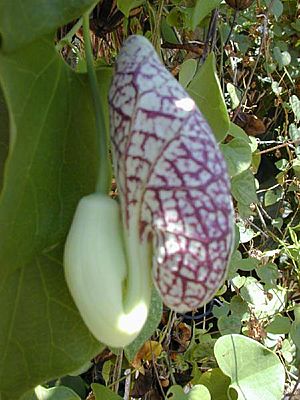Aristolochiaceae facts for kids
Quick facts for kids Birthwort family |
|
|---|---|
 |
|
| Calico Flower (Aristolochia littoralis), about to open | |
| Scientific classification | |
| Kingdom: | |
| (unranked): | |
| (unranked): | |
| Order: | |
| Family: |
Aristolochiaceae
|
| Subfamilies | |
|
Aristolochioideae |
|
| Synonyms | |
|
Asaraceae Vent. |
|
The Birthwort family, also known as Aristolochiaceae, is a group of flowering plants. This family includes seven different genera and about 400 species. They all belong to a larger group called the Piperales order. The most well-known genus in this family is Aristolochia.
Contents
What are Birthwort Plants Like?
Most plants in the Birthwort family are perennial plants. This means they live for more than two years. They can be herbaceous plants, which have soft stems. Some are shrubs, which are woody plants smaller than trees. You might also find them as woody vines or even very large lianas that climb high into trees.
Their leaves are usually thin and shaped like a heart. They grow one after another along the stem. The edges of the leaves are usually smooth. These plants do not have small leaf-like structures called stipules at the base of their leaves.
The flowers of these plants are quite unique. They can be large or medium-sized. They often have unusual shapes and grow where the leaves meet the stem. Some flowers are symmetrical on both sides, while others are symmetrical all around.
How Birthwort Plants are Classified
The Birthwort family belongs to a group called magnoliids. These are a very old group of angiosperms, which are plants that produce flowers and seeds. Magnoliids are different from the two main groups of flowering plants: monocots and eudicots.
In newer ways of classifying plants, the Birthwort family is placed within the Piperales order. This helps scientists understand how different plant families are related to each other.
Plant Defenses and Butterflies
Many plants in the Aristolochia genus and some in the Asarum genus contain a special chemical. This chemical is called aristolochic acid. It acts as a natural defense for the plant. It helps protect them from herbivores, which are animals that eat plants.
A Special Relationship with Butterflies
Interestingly, some animals are not harmed by this chemical. For example, the Pipevine swallowtail butterflies lay their eggs on Aristolochia plants. When the larvae (caterpillars) hatch, they eat the plant's leaves. They are not affected by the toxin in the plant.
In fact, eating the plant's leaves makes the caterpillars and later the adult butterflies taste bad to predators. This gives the butterflies protection from animals that might try to eat them. It's a clever way for the butterflies to use the plant's defense for their own safety!
See also
 In Spanish: Aristoloquiáceas para niños
In Spanish: Aristoloquiáceas para niños

